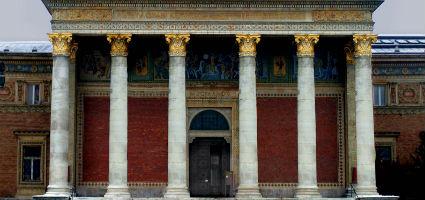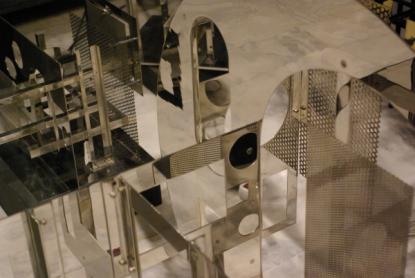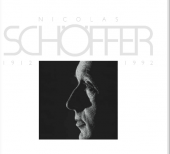2024. November 23. Saturday
Kunsthalle - Budapest
 |
Address: 1146, Budapest Dózsa György út 37.
Phone number: (1) 460-7000, (1) 363-2671
E-mail: info@mucsarnok.hu
Opening hours: Tue-Wed 10-18, Thu 12-20, Fri-Sun 10-18
|
The exhibition has closed for visitors.
Museum tickets, service costs:
|
Ticket for adults
|
1200 HUF
|
|
|
Ticket for adults
(valid for the Kunsthalle and the Ernst Museum)
|
1400 HUF
|
|
|
Group ticket for adults
(from over 10 people)
|
800 HUF
|
/ capita
|
|
Ticket for students
(EU citizens from the age of 6 to 26 )
|
600 HUF
|
|
|
Ticket for students
(valid for the Kunsthalle and the Ernst Museum, 6-26 years of age)
|
700 HUF
|
|
|
Group ticket for students
(from over 10 people)
|
400 HUF
|
/ capita
|
|
Ticket for pensioners
(valid for the Kunsthalle and the Ernst Museum, 62-70 years of age)
|
700 HUF
|
|
|
Ticket for pensioners
(EU citizens from the age of 62 to 70)
|
600 HUF
|
|
|
Ticket for families
(1 adults + 2 children)
|
1800 HUF
|
/ family
|
|
Ticket for families
(2 adults + 2 children)
|
2400 HUF
|
/ family
|
It is probably the first and last occasion that this extraordinary collection sourced form the one-time studio of Nicolas Schöffer, renowned for his kinetic light sculpture, will be exhibited in Hungary. The exhibition – realized through the cooperation of the artist’s widow – will present the futuristic-retro work of Nicolas Schöffer, the Hungarian-born French artist from October to January in the Műcsarnok. The objects on display will return abroad after the exhibition.

The planning and preparations of this 2 billion HUF insurance value exhibition took many years. The major aim of the curators was to help the rediscovery of the „magician of light”, the artist, who died in 1992. This is consonant with the fact that Unesco named 2015 the international year of light. Although there has been a Nicolas Schöffer permanent exhibit in his home town Kalocsa since 1980, his last major Hungarian exhibition was organized in 1982. This new exhibition will put on centerstage those sculptures which were preserved in the former studio of the artist and are still in the possession of his widow. The objects displayed were selected from the immense material preserved in the artist’s former studio.
The main emphasis of the exhibition is layed on those spatio-dynamic and lumino-dynamic sculptures which brought renown for the artist, but some of the early paintings – as Schöffer started his career as a painter – will also be displayed and some of his architectural designs and urban planning drawings, never realized, will be included. Aesthetically, the sculptures of Schöffer were considered to be pioneering, hypermodern works of art in his age. Kibernetic sculptures seemed to transform urban spaces by not only being present but also entering into a dialogue with and reacting to their environment, such as the weather, sound and light conditions in different ways. They can be interesting today in comparison with the ever faster digital revolution since then. The works of Schöffer create a futuristic-retro atmoshpere and confront us with how the future was seen to develop fifty years ago.
Curators: Zoltán Rockenbauer and György Szegő

The planning and preparations of this 2 billion HUF insurance value exhibition took many years. The major aim of the curators was to help the rediscovery of the „magician of light”, the artist, who died in 1992. This is consonant with the fact that Unesco named 2015 the international year of light. Although there has been a Nicolas Schöffer permanent exhibit in his home town Kalocsa since 1980, his last major Hungarian exhibition was organized in 1982. This new exhibition will put on centerstage those sculptures which were preserved in the former studio of the artist and are still in the possession of his widow. The objects displayed were selected from the immense material preserved in the artist’s former studio.
The main emphasis of the exhibition is layed on those spatio-dynamic and lumino-dynamic sculptures which brought renown for the artist, but some of the early paintings – as Schöffer started his career as a painter – will also be displayed and some of his architectural designs and urban planning drawings, never realized, will be included. Aesthetically, the sculptures of Schöffer were considered to be pioneering, hypermodern works of art in his age. Kibernetic sculptures seemed to transform urban spaces by not only being present but also entering into a dialogue with and reacting to their environment, such as the weather, sound and light conditions in different ways. They can be interesting today in comparison with the ever faster digital revolution since then. The works of Schöffer create a futuristic-retro atmoshpere and confront us with how the future was seen to develop fifty years ago.
Curators: Zoltán Rockenbauer and György Szegő



